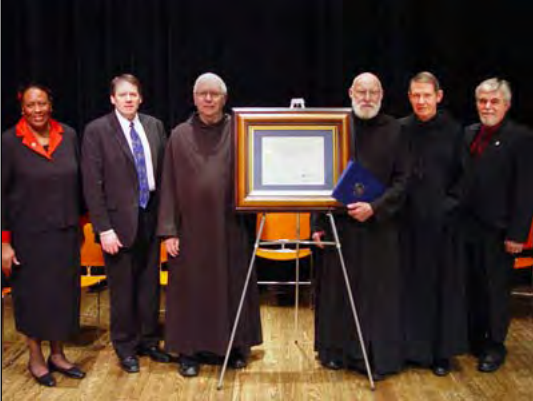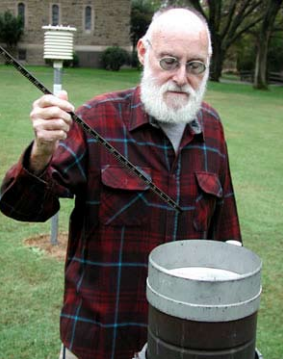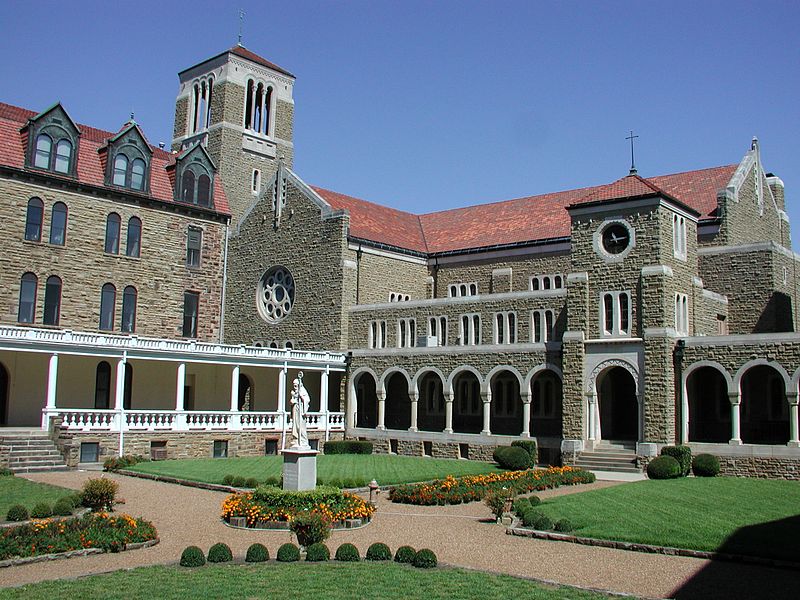Monk, Engineer, Weather Observer - National Weather Service Heritage

Monk, Engineer, Weather Observer
By NWS Heritage Projects TeamAbove: Brother Anselm Allen (3rd from right) receives the Thomas Jefferson Award in 2009, the highest honor given to an NWS cooperative weather observer
Editors Note: The following is adapted from an article in the Summer 2007 edition of the National Cooperative Observer.
 Brother Anselm Allen has been an NWS Cooperative Observer since 1965 at the Subiaco Abbey in Logan County, AR. Br. Anselm has the longest tenure as an observer since Benedictine Monks began taking weather observations at the Abbey over 120 years ago, on October 1, 1897. NWS Little Rock, AR, has come to rely heavily on his observations, which are characterized by their accuracy and timeliness.
Brother Anselm Allen has been an NWS Cooperative Observer since 1965 at the Subiaco Abbey in Logan County, AR. Br. Anselm has the longest tenure as an observer since Benedictine Monks began taking weather observations at the Abbey over 120 years ago, on October 1, 1897. NWS Little Rock, AR, has come to rely heavily on his observations, which are characterized by their accuracy and timeliness.
Br. Anselm’s weather reporting is exceptional. He rarely misses an observation. On the rare occasions he is unable to take the observations, he always ensures someone else records and reports them. In addition to his outstanding support of the NWS, he is active in the HAM radio net. HAM radio operators provide a valuable service to the NWS by reporting severe weather.
Br. Anselm was the recipient of the John Campanius Holm Award in November 2003. The award presentation received widespread local and international news coverage. His story was reported in France and Germany via the Associated Press. During the award ceremonies, the Abbey was acknowledged for its more than 100 years of service to the NWS with a Special Service Award. Br. Anselm is also Chief of the Abbey's Volunteer Fire Department. The fire department not only supports Subiaco Abbey, but they also assist the local community of Subiaco’s Fire Department. His role in town extends even further: Br. Anselm is a member of the Subiaco town council. And if all that isn't enough, Br. Anselm is the engineer for the Abbey's water treatment plant and maintains the Abbey's boilers.

Railroad Ties
The Abbey at Subiaco's history goes back 140 years. While traveling back to St. Meinrad from missionary activities in the Dakotas, Abbot Martin Marty, OSB, struck a deal with the agent of LR&FS Railroad Company, and in November 1877, he was granted 640 acres for a Benedictine monastery for men and 100 acres for a women's monastery. This agreement met with the blessing of Bishop Edward Fitzgerald of Little Rock, who needed German speaking priests in his diocese.
On Ash Wednesday, March 6, 1878, three monks—Fr. Wolfgang Schlumpf, Br. Casper Hildesheim and Br. Hilarin Benetz—departed St. Meinrad for Arkansas in a mule-drawn wagon. The three monks/missionaries arrived in Logan County, AR, on March 15, 1878. Though the land was rough and overgrown, the monks were inspired by the breathtaking view from their new home in the Ouachita Mountains.
Swiss Connection
The early years of St. Benedict’s Priory— renamed Subiaco Abbey in 1891—were indeed difficult ones due to limited funds and personnel from St. Meinrad, but Fr. Wolfgang never gave up on the project or lost sight of his pastoral duties. In cooperation with the abbot of St. Meinrad, Fr. Wolfgang wrote to the Abbey Maria-Einsiedeln in Switzerland for help.
The only way that St. Benedict’s Priory could survive was to have Einsiedeln's support. The Abbey Maria-Einsiedeln wanted the Arkansas mission to continue, therefore, throughout the years Swiss monks arrived to assist Fr. Wolfgang.
The success of the mission in Arkansas was assured in the fall of 1887 when Fr. Gall D’Aujourd’hui and eight novices from Einsiedeln—called the “Eight Beatitudes”— arrived on the scene. The dream was now realized with Fr. Gall’s arrival; he is considered the co-founder of Subiaco Abbey.
After the successful establishment of a monastery and several German speaking Catholic Churches in the Logan County area, the monks opened a school for young men, which has evolved over the last 100 years into the present Subiaco Academy, a college-prep boarding school. The abbey also developed a strong retreat ministry with the opening of Coury House Retreat Center in April of 1963, which continues to flourish with visitors and wayfarers from across the nation. And of course, it continues its tradition of supporting the nation's climatic database through Br. Anselm!
